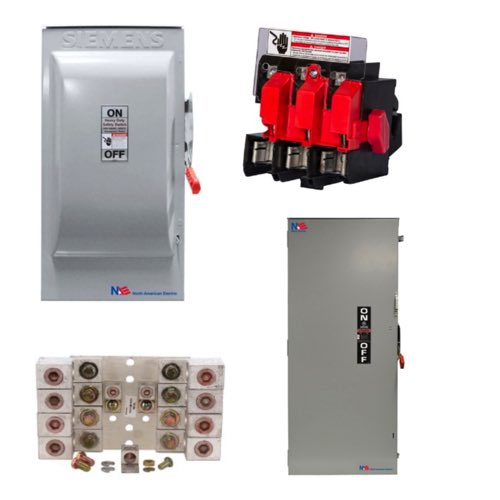NAE Disconnects

In a variety of industrial and commercial applications, NAE disconnects are used as electrical isolation devices to guarantee the safe maintenance and running of electrical circuits. NAE disconnects are set apart by their reliability to consistently signal to an electrical operator that a piece of equipment—in this case, a switch—can be shut off and safely worked on.
When their user-friendly handle is placed in the off or "open" position, an NAE disconnect achieves a safe non-contact break in an electrical circuit. It does this because within its "open" switch position, it affords a highly insulated air gap in which no current can flow. The NAE disconnect can be trusted to provide an electrical operator with a "clear sight" and "clear signal" safety mechanism.
Disconnects vs Circuit Protection
Disconnects
Disconnects are intended to remove and restore power from any electrical equipment that is downstream of that disconnect. In most cases, this is a manual operation and is actuated only when power needs to be removed or restored to a particular circuit. Disconnects do not typically provide any type of state monitoring ability nor do they offer any type of circuit protection, they are simply used to remove and restore power. It is common to see electrical disconnects used in situations where larger amounts of voltage are present. External disconnects function by allowing the operation of switching power to be performed outside of an electrical enclosure. It is also common to see disconnects require power to be shut off before the enclosure can be opened. This type of disconnect is found on circuits with high voltage potentials and allows for much safer operation when the electrical equipment inside the enclosure needs to be accessed.
Circuit Protection
Circuit protection devices, such as circuit breakers and fuses, function differently from disconnects in that they have the ability to disconnect power to any devices downstream from their location by monitoring current and power surge events. They are not designed to operate as a switch. When using fuses, if an overcurrent event or surge occurs, they will need to be replaced as they are only intended to be used once. Circuit breakers can be reset, but are not intended to switch power on and off as their main function. In many cases it is necessary to have both an electrical disconnect and a circuit protection device to ensure that any hardware on the circuit does not become damaged because of overcurrent or power surges.

